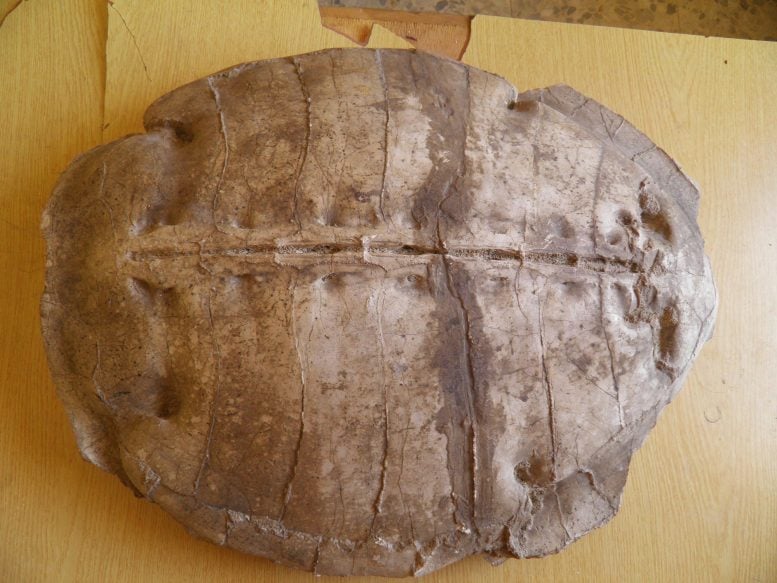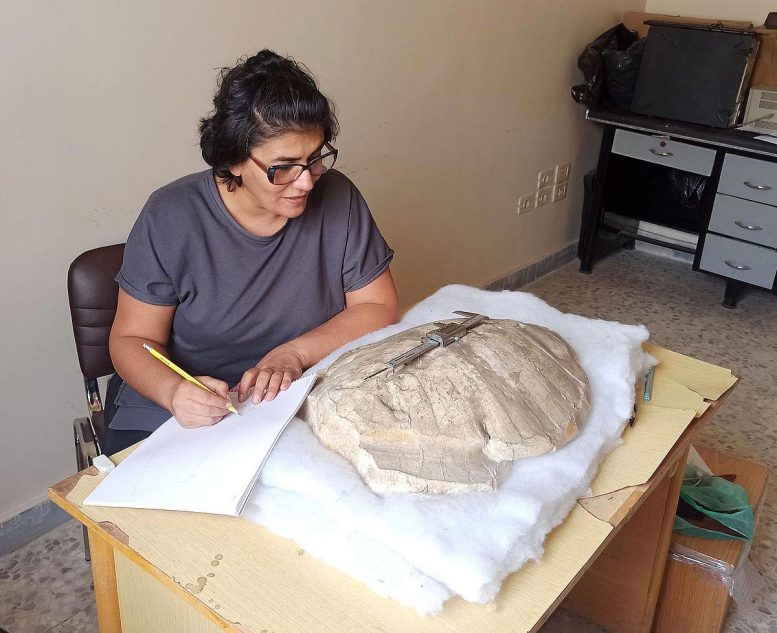
Scientists discovered Syriemys lelunensis, a 50-million-year-old fossil sea turtle from Syria.
Near the city of Afrin in Syria, an international group of scientists, including members of the Senckenberg Centre for Human Evolution and Palaeoenvironment at the University of Tübingen, has identified a previously unknown species of fossil sea turtle. Named Syriemys lelunensis under the direction of the University of São Paulo, the species dates to the early Eocene, roughly 50 million years ago.
The discovery consists of a fully preserved internal cast of the shell along with sections of the ventral carapace, pelvis, and hind limbs. It represents the first fossil vertebrate species ever formally described from Syria.
The fossil shows an oval-shaped carapace that is well preserved, measuring 53 centimeters in length and 44 centimeters in width.
“For 13 years, the bone fragments from the Eocene period were stored in the office of the General Directorate of Geology and Mineral Resources in Aleppo after their recovery in 2010 during a quarry blast at Al-Zarefeh near Afrin,” explains Wafa Adel Alhalabi, a Syrian-Brazilian paleontologist and lead author of the study at the University of São Paulo, Brazil. She adds, “Together with colleagues from Brazil, Syria, Germany, Lebanon, and Canada, we have now been able to scientifically describe this animal.”
Age determination based on tiny shells from the rock
The species, named Syriemys lelunensis, represents the first and so far only fossil vertebrate to be formally described from Syria. The discovery also provides the earliest known evidence of the Stereogenyini, an extinct group of side-necked turtles, pushing their evolutionary history back by more than ten million years.
The fossil material includes a completely preserved internal mold of the carapace, along with portions of the ventral shell, pelvic bones, and hind limbs—some of which are incorporated into the cast itself. To help establish the fossil’s age, researchers analyzed tiny foraminifera extracted from the surrounding rock.
“These shell-bearing protozoa were crucial in determining the age of the fossil turtle,” notes Alhalabi.

“Today, all members of the side-necked turtle family are semi-aquatic freshwater turtles. However, the now-extinct Stereogenyini also inhabited saltwater habitats. Therefore, their fossils can be found all over the world: in South America, North America, the Caribbean, Africa, and East Asia,” explains Dr. Gabriel S. Ferreira from the Senckenberg Centre for Human Evolution and Palaeoenvironment at the University of Tübingen.
Present-day Syria was entirely covered by water throughout the Cretaceous period and until the late Miocene, i.e., from 145 million to around 5.3 million years ago. Given this extensive marine past, it is no big surprise to Ferreira that a sea turtle was found there. “However, the discovery of Syriemys lelunensis now adds a new geographical location to the distribution of the Stereogenyini – and there are clear indications of a possible origin of this group of sea turtles in the Mediterranean region.”
Complex political situation
“The current situation in Syria is extremely complex, and in view of the tragedies unfolding there, it seems almost surreal to talk about fossils. But at the same time, the publication of the find illustrates the country’s potential and the fact that science is still alive there,” emphasizes Professor Max Langer, senior author and head of the PaleoLab at the Brazilian university.
The research team plans to continue its work with a series of articles entitled “Recovering lost time in Syria.” The series is based on materials that Alhalabi personally observed on site and documented photographically. “The title is not only intended to refer to the country’s geological past, but also to the time when science in Syria was at a standstill,” adds Ferreira in conclusion.
Reference: “Recovering lost time in Syria: a new Eocene stereogenyin turtle from the Aleppo Plateau” by Wafa A. Alhalabi, Donato J. Martucci Neto, Gabriel S. Ferreira, Issam Bou Jaoude, Hassan M. Naser, Jouliana Ayoub, Lama Abboud, Rim Shati, Eduardo A. M. Koutsoukos and Max C. Langer, 23 July 2025, Papers in Palaeontology.
DOI: 10.1002/spp2.70026
Never miss a breakthrough: Join the SciTechDaily newsletter.
8 Comments
I don’t see any evidence of the paleontologists being ‘stunner’ – this is supposed to be a scientific site, not one given over to juvenile hyperbole.
These are all lies. There is no such thing as a million years. This us only 2025. The news is only entertainment.
Are you really that dense?
Apparently they are THAT dense! They must be a brainLESS trump supporter! Lol I swear all trumpets are dumb as ROCKS! Haha
Apparently they are THAT dense! They must be a brainLESS trump supporter! Lol I swear all trumpets are dumb as ROCKS! Haha. Sat is probably a liar and conspiracy theorist and everything wrong with society these days!
Felt so strong you had to say the same thing twice, huh. Libbies…you’re all the same. Do nothing but insult because you THINK you’re mentally superior or more intelligent or more educated. In actuality, you’re everything you claim to be better than.
Yes 2025 A.C.E.
50 million years. I love how they just make up absurd numbers as if they really have a remote clue. Don’t bring up flawed “carbon dating” drivel.